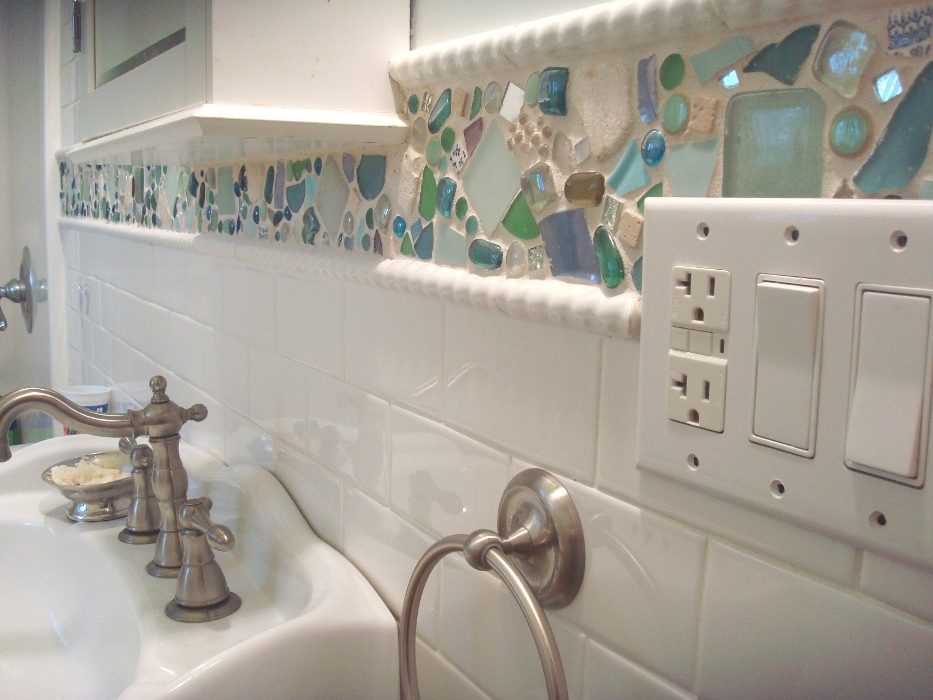Sea and beach glass are different. Sea glass refers to salt water glass and beach glass refers to fresh water glass. The difference is that glass slowly dissolves in salt water, which gives sea glass a satin-like patina, while it does not dissolve in fresh water. This is because the Ph of salt water is different from that of fresh water.
   origin of seaglass origin of seaglass
Sea and beach glass is found everywhere in the world, because people have discarded glass in the oceans and waterbodies everywhere. It was natural for waterfront communities worldwide to discard their trash in the water because the water carried it away. Landfills were a terrible health hazard in those days, filled with vermin that carried dangerous diseases like the Plague. The world was a much larger place in those days and the population was much smaller. It just made good sense at the time. This practice is still followed in many third world countries.

1.) Common Colors: Kelly Green, White, Brown
2.) Uncommon Colors: Soft green (Seafoam), Soft blue, Olive green, Lime green, Golden amber, Amber
3.) Rare Colors: Pink, Citron, Deep Seafoam, Teal Green, Aqua, Cobalt blue, Cornflower blue, Purple (lavender)
4.) Extremely Rare: Orange, Red, Yellow, Turquoise, Teal blue, Gray
Everywhere Sea Glass is found, and it is found everywhere, its value is partially determined by its color. This is because only a few items were stored in red, blue, lavender, purple or pink glass containers. Likewise certain rare tints and shades of these popular colors are found.
For instance, very rare Cobalt Blue, the "sapphire" of the beach, came from such apothacary items as Milk of Magnesia, Vick's Vapo Rub, Noxema, Nivea, and Bromo Seltzer bottles, along with some prescription bottles and perfumes
    jewelery jewelery
 wall decoration wall decoration
The extremely rare red pieces, or "rubies" of the beach, might come from perfume bottles, the tail lights on old automobiles, lantern and traffic light lenses, or even some types of old beer bottles, like the bottles made by Anchor Hocking for Schlitz Beer in the 1950's.
Pinks, lavenders, purples, lime greens and other rare shades came from things like perfume bottles and art glass. Many lavenders and pinks come from what was originally clear glass that was clarified with magnesium (lavender) or selenium (pink). The glass has to be clarified with these minerals because the sand from which glass is made is actually amber in color. Over time the sun causes the magnesium and selenium to oxidize, creating the lavender and pink colors.
Greens, browns, and aquas come from beer and soda bottles, and nearly every other source, like Clorox Bleach jugs, shampoos, etc.
And sometimes, like in the old town dumps in Fort Bragg, California, the sea glass is also passed through fires and becomes "Fire Glass", the rarest of sea glass, and often has "inclusions" (things inside), just like, or better than, precious gems.
In fact, gemological terms like "inclusions", "clarity", "color", "facets" and "purity" also pertain directly to sea glass, except that inclusions and "impurities" are bad in gemstones and often excellent in sea glass, and a lot of people prefer their sea glass "frosted" instead of clear (unless there are "inclusions") and no one would think of buying a cloudy diamond, except to HIDE an inclusion!
Sea glass goes back in history for as long as man has had glass.
As the raw glass is broken into smaller pieces and slowly polished by the sand as it is rolled around in the surf, it becomes "beach", or "sea" glass:
sumber 1 sumber 2
ps: kalau jalan2 di tepi pantai tgk2 sikit kat pasir tu , kalau ada boleh kutip!
|